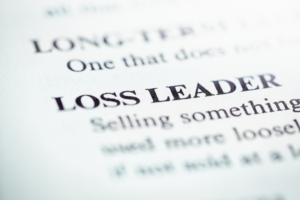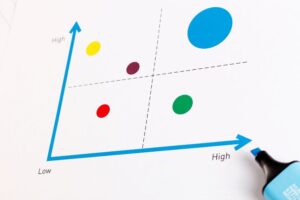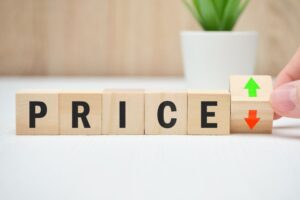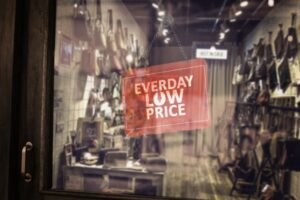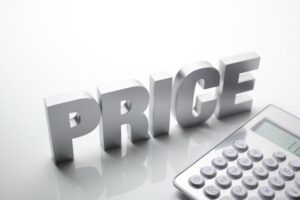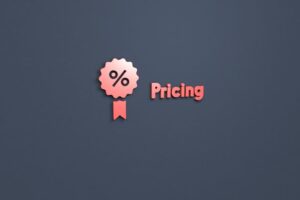What is High-Low Pricing?
High-low pricing is a pricing strategy where a company sets the initial price of its products or services higher than its competitors, but frequently offers sales, promotions, or discounts. This strategy seeks to attract customers by creating a sense of value during the high-price phase and driving sales with periodic discounts.
The combination of a high “reference” price and a lower “sale” price is the basic mechanism driving high-low pricing.
The Psychology Behind High-Low Pricing
The high-low pricing approach uses a psychological phenomenon known as “anchoring.” Anchoring refers to our natural tendency to judge based on the first piece of information presented (the ‘anchor’). In the context of high-low pricing, the originally high set price is the anchor.
When customers see a high initial price followed by a discounted rate, they see the lower price as a bargain in comparison to the anchor price. Even though the discounted price is still relatively expensive in comparison to market alternatives, the client views it as a good bargain, increasing the chance of purchase.
High-low pricing takes advantage of the way consumers think. When people see a high price, they think to themselves, “That’s what it’s worth.” When they notice that the price has been dropped, they exclaim, “Wow, that’s a great deal!” The difference in prices makes the discount appear larger and more thrilling.
High-low pricing can also create a sense of urgency. When a sale is only available for a limited time, shoppers may feel compelled to purchase immediately or risk missing out on the discounts. This is similar to the psychological concept that individuals usually desire things more when they are scarce or running out.
MORE: Psychological pricing explained
High-Low Pricing Strategy Examples
Smartphones
Almost all smartphones are introduced at a high price point and then progressively discounted as the excitement subsides and new models are introduced.
While Apple popularized this smartphone pricing strategy, Samsung, Google, Huawei, and other brands now follow suit.
MORE: What is prestige pricing?
Adobe Creative Cloud
With its Creative Cloud products, Adobe employs high-low pricing. Individual software subscriptions, such as Photoshop or Illustrator, are comparatively more expensive for customers.
Adobe offers a significant discount if customers purchase the entire suite of products for a year. This pricing strategy encourages customers to commit for an extended period and invest in various products.
MORE: Freemium business model
Black Friday Sales
Black Friday event perfectly illustrates high-low pricing on a huge scale. Retailers frequently promote exceptionally significant discounts on products to attract many customers. These products are often sold at greater prices throughout the remainder of the year.
MORE: What is odd even pricing?

When to Use High-Low Buying
1. When launching a new product
High-low pricing can be beneficial during a product launch. Setting a high initial price generates a perception of value and quality. Subsequent promotions or discounts might therefore attract buyers who are price-sensitive or hesitant to test a new product.
2. During peak buying seasons
If your company’s sales fluctuate seasonally, high-low pricing may benefit during peak buying seasons. Set usual pricing high during off-peak periods, then give promotions or discounts to drive sales during peak seasons.
3. To move inventory
High-low pricing might stimulate speedy sales if you need to clear out inventory quickly, whether to create a place for new goods or minimize carrying costs. Customers are frequently more ready to buy when they believe they are getting a good bargain.
4. To attract price-sensitive customers
High-low pricing might be helpful in marketplaces with price-sensitive clients. The ‘sale’ pricing can make the goods or service more accessible to clients who might not otherwise be able to afford it.
MORE: What is charm pricing?
5. In competitive markets
High-low pricing might help differentiate your product or service in a market with heavy competition. It can generate a sense of value that other pricing techniques may not.
In the SaaS sector, high-low pricing is sometimes expressed as reduced prices for yearly subscriptions vs monthly subscriptions. This encourages clients to sign longer-term contracts, resulting in predictable income for the organization.
Remember that implementing high-low pricing necessitates thoroughly understanding your consumers, market circumstances, and your product or service’s value proposition.
MORE: What is bundle pricing?
Advantages of High Low Pricing Strategy
Customer Acquisition and Revenue Predictability
High-low prices are a strong tool for getting new customers. A good deal can bring in more people and grow a business’s market share. Also, because discounts are often given for longer-term contracts or bigger purchases, they can make it easier to predict how much money will come in.
For example, software companies frequently use high-low pricing by offering discounted annual plans that attract consumers and provide a year’s worth of revenue upfront.
Customer Retention Improvement
This pricing structure can also improve customer loyalty. By encouraging customers to commit for an extended period in exchange for a discount, businesses can increase the likelihood that these customers will remain loyal.
Customers may become more closely associated with the company’s ecosystem over time, further reducing the likelihood of decline.
Sell Slow-moving Products
Utilizing a high-low pricing strategy is one of the best methods to sell slow-moving inventory. A price reduction from a previous peak point could be sufficient to persuade buyers to low-selling products.
MORE: What is penetration pricing?
Disadvantages of High Low Pricing Strategy
Managing Customer Expectations
Customers may develop a habit of purchasing only during promotions and protest at regular, higher prices. This anticipation may result in irregular demand, with peaks during promotional periods and lulls in between.
The Risk of Eroding Perceived Value
Continuously discounting a product or service risks diminishing its perceived value. Customers may associate a product’s discounted price with its value if they frequently encounter it at a reduced price.
Balancing Customer Acquisition Against Profitability
There is a delicate line between acquiring new customers and maintaining profitability. Each discount reduces profit margins, which can be mitigated by increased sales volume, but it is essential to strike the right balance.
Advantages and Disadvantages Summary
| Advantages | Disadvantages |
| Customer acquisition and revenue predictability. | Managing customer expectations |
| Customer retention improvement. | The risk of eroding perceived value |
| Sell slow-moving products. | Customer acquisition against profitability. |
How to Use High-Low Pricing
The high-low pricing strategy’s performance depends on the careful balancing and strategic execution of price choices.
While enticing discounts are necessary, increasing the original price may repel potential buyers. On the other hand, discounts that are too deep or too frequent might degrade the perceived value of the product or service.
Tips to Use High-Low Pricing
Here are a few tips for exploring high-low pricing:
- Recognize your customers: Understanding your customer’s willingness to pay for your service is critical. Investigate your market to determine the price range your clients are comfortable with.
- Be strategic: To retain the perceived value of the product, use discounts sparingly and intelligently. Too many discounts may cause customers to wait for purchases, lowering your earnings and decreasing client lifetime value.
- Communicate your value: Ensure your consumers understand the value of your product or service. The perceived value should justify both the high and low prices.
- Maintain a balance of promotion types: Consider a combination of promos such as percentage discounts, buy-one-get-one deals, and limited-time specials. Different promos appeal to different client categories and can contribute to a more dynamic shopping experience.
- Monitor and adapt: Track the effectiveness of your high-low pricing approach on a regular basis. Monitor sales, customer feedback, and inventory turnover. Use this information to adjust and refine your strategy to ensure that it remains effective in shifting market conditions.
- Cultivate exclusivity: Offer unique discounts or early access sales to loyal customers or subscribers on occasion. This not only rewards loyalty but also highlights the exceptional quality of your items, making the expensive price more justified.
What Makes a High-Low Pricing Strategy Appealing to Sellers?
Higher Margins During Non-Sale Periods
When a product is priced higher than its competitors, the profit margin is inherently bigger.
This higher margin might help offset lower earnings during sales seasons and allow more flexibility in operational costs or other business expenses.
Price Discrimination
Some clients are willing to pay a premium for fast pleasure or a superior product, while others will wait for a price reduction.
High-low pricing capitalizes on this customer habit, effectively segmenting the market based on willingness to pay and increasing revenue from both categories.
Improved Perceived Value
Consumers frequently associate price with quality. A higher usual price might anchor the product’s perceived worth at a higher point, so when it goes on sale, customers believe they’re getting a high-quality product for a deal, increasing their total purchase satisfaction.
Excitement and a sense of urgency
Customers experience a “fear of missing out” (FOMO) when limited-time incentives are available.
This sense of urgency might enhance impulse purchases, driving sales volumes during promotional periods.
The uncertainty of when the next deal will occur can also retain consumer attention and expectations.
Inventory control
High-low pricing allows businesses to transfer outdated or overstocked products efficiently.
By selling these goods, sellers can free up shelf or storage space and save holding expenses, all while generating a place for new products or collections.
Brand Recognition and Loyalty
Regular sales events can become an integral element of a brand’s identity. Customers may look forward to their favorite brand’s yearly or semi-annual sale, making it a highly anticipated event.
Over time, this can cement brand loyalty and promote habitual purchase patterns among consumers.
High-Low Pricing vs. Everyday Low Pricing (EDLP)
High-Low Pricing sets an original price point higher than the competition but then offers frequent promotions and sales to create the perception of value. The price reduction helps to encourage consumers to make immediate purchases.
On the other hand, everyday Low Pricing (EDLP) maintains consistently low prices and positions itself as a “discount brand.”
Unlike High-Low pricing, EDLP pricing begins low and remains low. This pricing strategy seeks to attract a constant stream of budget-conscious customers by ensuring they can always anticipate low prices without waiting for sales or discounts. Walmart is a classic example of a company that employs the EDLP strategy successfully.
| High-Low Pricing | Everyday Low Pricing |
| Original price set higher than competition. | Consistently low prices without fluctuation. |
| Frequent promotions and sales. | Positioned as a “discount brand”. |
| Creates a perception of value. | Attracts budget-conscious customers expecting stable prices. |
| Encourages immediate purchases during sales. | No need to wait for sales or discounts. |
MORE: What is a tiered pricing strategy?
Key Takeaways
Although not a novel concept, high-low pricing has found a home in the SaaS industry, providing businesses with a tool to improve customer acquisition and retention while increasing revenue predictability.
Although it is an effective instrument, businesses must employ it strategically to avoid pitfalls. It should be utilized as part of a larger pricing strategy that considers market dynamics, company offerings, and customer behavior.
As the SaaS industry continues to expand and evolve, high-low pricing will unquestionably remain a key pricing instrument for SaaS companies, highlighting the need for a strategic and balanced approach.
Check our SaaS pricing reviews and details about SaaS tools in our SaaSGenius pricing website.
Related Posts
Frequently Asked Questions (FAQ)
Author
Methodology
- Who?
We are SaaS experts: Our specialists constantly seek the most relevant information to help support your SaaS business. - Why?
We are passionate about users accessing fair SaaS pricing: We offer up-to-date pricing data, reviews, new tools, blogs and research to help you make informed SaaS pricing decisions. - How?
With accurate information: Our website manager tests each software to add a Genius Score using our rating methodology to each product. Our editorial team fact-check every piece of content we publish, and we use first-hand testing, value metrics and leading market data.
